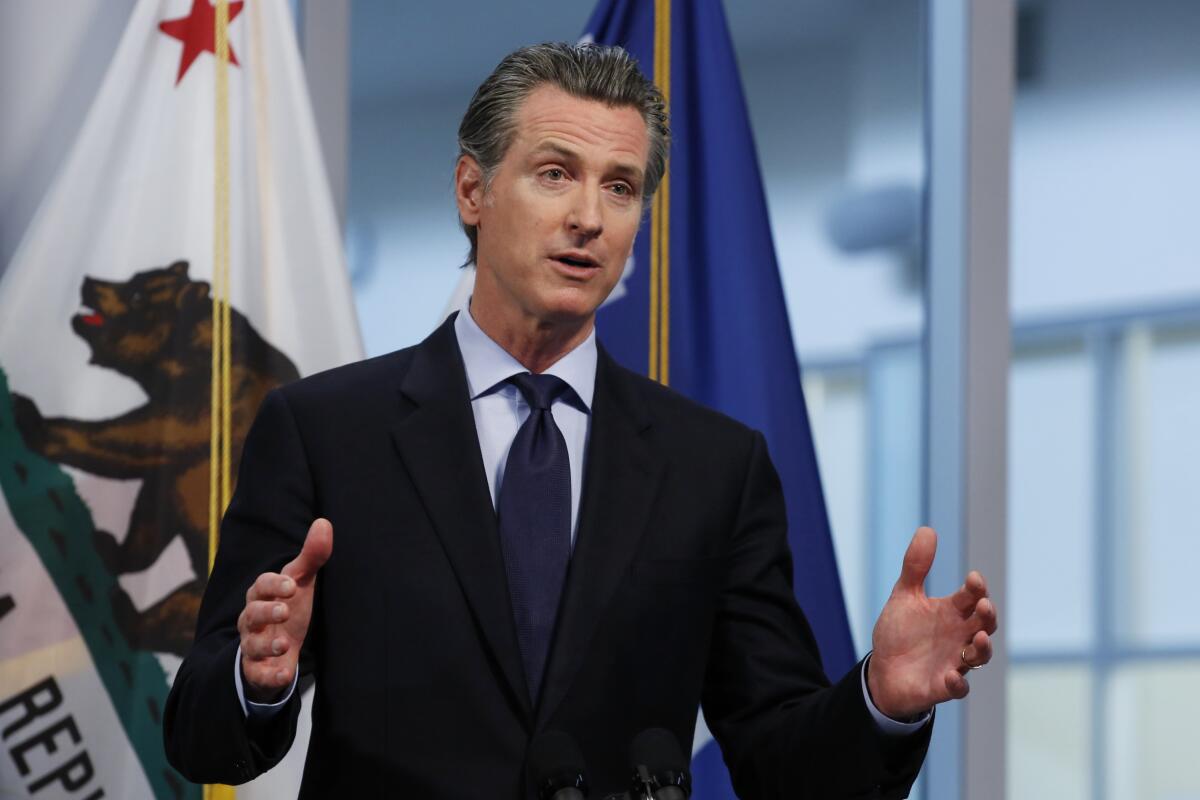Give Newsom credit. He’s trying it all to fight coronavirus and California’s economic collapse

- Share via
SACRAMENTO — Gov. Gavin Newsom has been throwing lots of stuff on the wall and hoping it sticks — sort of like FDR during the Great Depression.
No, I’m not really equating Newsom with Franklin D. Roosevelt, the greatest president of the 20th century.
For one thing, Roosevelt was one of history’s most inspiring and comforting orators. Newsom tries, but he’s long-winded, repetitive and jargon-prone: “Meet this moment.” “In real time.”
But California’s governor deserves lots of credit for — like Roosevelt — trying many things as the state staggers through a health pandemic and economic collapse.
Newsom is announcing a new project virtually every day. Some of the Democratic governor’s ventures may not work. Others will and they’ll help get us through this awful time.
“I don’t think anyone could do any better,” says Allan Zaremberg, president of the California Chamber of Commerce and a former top advisor to the late Republican Gov. George Deukmejian.
The most high-profile and potentially productive thing Newsom has done is create a “Task Force on Business and Jobs Recovery.” Its task, the governor’s announcement read, is “to develop recommendations for a plan that works for all Californians, with a focus on the regions and communities hardest hit by the pandemic….
“The task force will craft ideas for short, medium and long-term solutions that … emphasize a fair and equitable recovery.”
OK, that’s typical eye-glazing government-speak, but this “blue ribbon” commission is truly top of the line, loaded with brainy, practical Californians with extraordinary career successes. Many could be successful governors, if they ever had the desire to become politicians.
In fact, four “honorary” members were governors: Democrats Jerry Brown and Gray Davis, and Republicans Arnold Schwarzenegger and Pete Wilson. It’ll be interesting to learn what they contribute, if anything. Brown and Schwarzenegger, in particular, are used to running the show and aren’t really committee types.
One huge hurdle is that the task force is gigantic. I count 93 members. How can that many people, representing a wide swath of business and labor, ever reach a consensus on anything meaningful? Maybe they won’t. Maybe they’ll merely reach consensus by subcommittees.
It reminds me of the old line about what a camel is: It’s a horse designed by a committee.
But this committee is truly promising. It’s co-chaired by former Democratic presidential candidate Tom Steyer, a billionaire who made his fortune by managing a hedge fund. The other co-chair is Newsom’s chief of staff, Ann O’Leary, who once worked for Steyer at his Center for the Next Generation, a nonprofit that focused on economic issues.
Other members include Apple Chief Executive Tim Cook, Disney Executive Chairman Bob Iger, Bloom Energy founder Dr. K.R. Sridhar, Times owner Dr. Patrick Soon-Shiong and Zaremberg.
There are 14 union leaders, including Art Pulaski, executive secretary-treasurer of the California Labor Federation.
Newsom also wisely placed on the commission the four legislative leaders — two Democrats, two Republicans — and Lt. Gov. Eleni Kounalakis, whose family made a fortune in housing development and knows much about the business.
My cynical nature tells me one reason Newsom created this colossal committee of California VIPs was to insulate himself from their possible criticisms of his performance. These are people a governor needs on his side. It was a smart move.
Practically the only people left off the task force are large growers and owners of major sports teams. Too bad. What’s another dozen members?
The committee’s usefulness in helping Newsom chart a path out of the economic disaster will depend on the practicality of their solutions — no pie-in-the-sky fantasies — and whether the governor listens.
Newsom showed his sincerity by naming his top advisor as the co-chair and placing seven other high administration officials on the committee. They include his Cabinet secretary Ana Matosantos, a former state finance director and another ex-Steyer aide.
An unknown: Will these VIPs actually participate in the deliberations or shuck off their duties to underlings?
For enlightenment, I called Steyer, a climate change and “impeach Trump” activist. But he didn’t want to speak on the record, fearful of upstaging the governor.
I emailed the governor’s office twice for details and got no response.
So I called Zaremberg, a longtime major player in Sacramento politics.
“We need to find a way to get out of this shutdown,” he said. “We’re not going to get out of this until we allow public contact. Not just in restaurants, but airport concessions, dentists, tourism. … We have to mitigate the risks by other ways than staying apart. The only solution cannot be keeping our distance.
“Science is going to have to lead us out of this.”
Zaremberg says the state must put heavy emphasis on increasing testing and treating the ill. Newsom says he’s trying.
I also called the other end of the economic spectrum: Robbie Hunter, president of the State Building and Construction Trades Council of California. He’s a powerful labor lobbyist.
Hunter offered some hope. He talked about compromising on a longtime developer bugaboo: the California Environmental Quality Act, which often slows down projects because of long, drawn-out lawsuits.
He suggested streamlining the CEQA appeals process for major projects — just as the Legislature has previously done for sports stadiums and arenas.
“I think that’s doable,” Hunter said.
Let’s hope this task force lives up to its promise — and its report isn’t merely tossed on a shelf to collect dust, as has happened to so many previous “blue ribbon” commissions.
More to Read
Sign up for Essential California
The most important California stories and recommendations in your inbox every morning.
You may occasionally receive promotional content from the Los Angeles Times.














